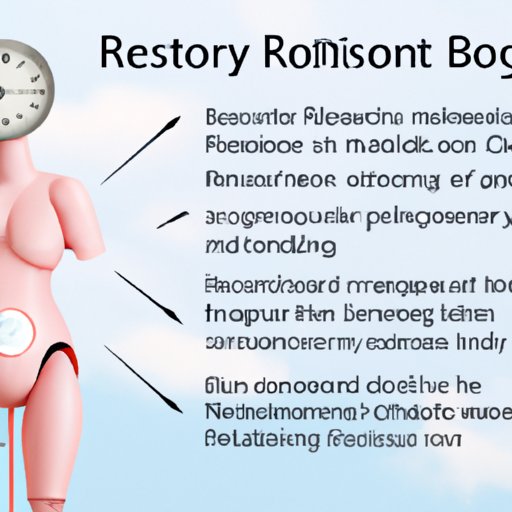Introduction
A robotic hysterectomy is a minimally invasive surgical procedure in which a robot-assisted device is used to remove all or part of the uterus. It is typically done for the treatment of gynecological conditions such as uterine fibroids, endometriosis, or cancer. In comparison to open surgery, the use of a robotic device allows the surgeon to perform the procedure with greater precision. As with any surgery, there is a period of recovery following a robotic hysterectomy. In this article, we will explore what to expect from a robotic hysterectomy recovery, the benefits of this procedure, and tips on how to speed up recovery after the surgery.
What to Expect From a Robotic Hysterectomy Recovery
Following a robotic hysterectomy, patients are usually discharged from the hospital within 1-2 days. The typical recovery time is 4-6 weeks, but this may vary depending on the individual and the complexity of the procedure. During the first few days after the surgery, patients may experience some pain and discomfort, as well as fatigue, nausea, and vomiting. It is important to follow the post-surgery instructions provided by your doctor to ensure a smooth and speedy recovery.
In rare cases, complications may arise during or after the surgery. These include infection, bleeding, and damage to surrounding organs. If any of these occur, additional treatment may be necessary and the recovery time may be longer. It is important to discuss any potential risks and complications with your doctor prior to the surgery.

The Benefits of Robotic Hysterectomy and its Recovery Time
Robotic hysterectomy has many advantages over traditional open surgery. One of the main benefits is that it reduces the risk of infection. According to a study published in the journal Gynecologic Oncology, the rate of postoperative infections was found to be significantly lower in patients who underwent robotic hysterectomy than those who underwent open surgery (1).
Robotic hysterectomy also results in less blood loss compared to open surgery. This is because the surgeon is able to make smaller incisions, resulting in reduced tissue trauma. Additionally, robotic hysterectomy is associated with a shorter recovery time due to the minimally invasive nature of the procedure. Patients are usually able to return to their normal activities within a few weeks following the surgery.
Tips on How to Speed Up Recovery After a Robotic Hysterectomy
There are several things you can do to facilitate a speedy recovery following a robotic hysterectomy. First and foremost, it is important to follow the post-surgery instructions provided by your doctor. This includes taking medications as prescribed, getting enough rest, and avoiding strenuous activities.
It is also important to stay hydrated and eat a healthy diet. Eating nutrient-rich foods can help reduce inflammation, promote healing, and boost energy levels. Additionally, managing pain properly is essential for a successful recovery. Over-the-counter pain relievers can be used to manage mild to moderate pain, while stronger medications may be prescribed by your doctor if needed.

Comparing Recovery Times for Different Types of Hysterectomies
Robotic hysterectomy is not the only type of hysterectomy available. Other common types include abdominal hysterectomy, vaginal hysterectomy, and laparoscopic hysterectomy. Each of these procedures is associated with a different recovery time.
Abdominal hysterectomy is the most invasive type of hysterectomy and typically requires an overnight hospital stay. Recovery time is typically 6-8 weeks. Vaginal hysterectomy is less invasive and involves a shorter recovery time of 4-6 weeks. Laparoscopic hysterectomy is the least invasive type of hysterectomy and typically requires a shorter recovery time of 2-4 weeks.

Understanding the Impact of Robotic Hysterectomy on Recovery Time
Robotic hysterectomy offers several potential benefits over traditional open surgery. One of the main benefits is a lower risk of complications. This reduces the risk of prolonged recovery and allows patients to resume their normal activities sooner. Additionally, robotic hysterectomy is associated with faster return to normal activities such as walking, driving, and returning to work.
Questions to Ask Your Doctor About Recovery Time Following Robotic Hysterectomy
If you are considering having a robotic hysterectomy, it is important to talk to your doctor about what to expect during recovery. Here are some questions to ask:
- What is the average recovery time following a robotic hysterectomy?
- What are the possible complications and associated recovery times?
- What can I do to speed up my recovery?
Conclusion
Robotic hysterectomy is a minimally invasive surgical procedure that can be used to remove all or part of the uterus. The typical recovery time is 4-6 weeks, but this may vary depending on the individual and the complexity of the procedure. Robotic hysterectomy has several potential benefits, including a lower risk of infection and a shorter recovery time. To ensure a speedy and successful recovery, it is important to follow the post-surgery instructions provided by your doctor and to manage pain properly.
(Note: Is this article not meeting your expectations? Do you have knowledge or insights to share? Unlock new opportunities and expand your reach by joining our authors team. Click Registration to join us and share your expertise with our readers.)
